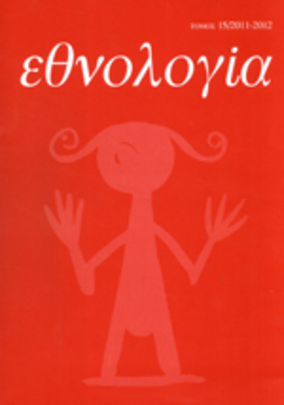Οι παράγοντες που επέδρασαν στο μετασχηματισμό της αμοργιανής σούστας
Part of : Εθνολογία : περιοδική έκδοση της Ελληνικής Εταιρείας Εθνολογίας ; Vol.3, No.1, 1994, pages 85-117
Issue:
Pages:
85-117
Parallel Title:
The factors that influenced the modification of the form of the dance “sousta” of the island of Amorgos
Author:
Abstract:
The «sousta» of Amorgos differs in its dancing form compared to the frequent form of the «sousta» dance that is performed in the other islands of the Aegean Sea, and is characterised by the complexity and versatility of its dancing execution. This paper attempts an anthropological approach to the dance. The approach includes the analysis of the dance into its structural and morphological characteristics along with the historical and social consideration of the conditions that influenced that particular modification. The research begun with the recording of the dance as performed by the cultural associations of the people of Amorgos in Athens, and, in the process, an older form of the dance that was performed at the island till 1950, has been traced. It should be underlined that nowadays none of these forms is danced at the island of Amorgos.Through the comparison of the two forms, the changes are located on the dancing shape, the combination of the choreographic sections, the variety and the succession of the dancing motives. In its older form, the dance is performed by one couple, whilst in its later form it is performed by several couples that during the dance join and form an open circle. This form automatically restricts improvisations and the free kinetic expression of the couples. Moreover, the music arrangement and the sequence of the musical units are determinatively influencing the combination of the dancing motives and the performance of the dance.The emigration that followed World War II, is one of the factors that influenced determinatinely the performance of the dance. That is due to the fact that the «sousta» was transported form the island environment and transplanted to an urban environment. In our days this dance is performed only by the cultural associations of the people of Amorgos in the context of dance events.These associations aim to the preservation of their dance tradition. The «sousta», as a part of that very tradition, is the product of many rehearsals, fact that inevitably leads to the artistic performance of the dance. This kind of performance implies the participation of several couples and the uniform performance of the dance in order to make it pleasing and impressive for the spectators, whose aesthetic views have also undergone changes. Therefore, regarding the later form of the «sousta», the object of the dance act is to make a good impression with the performance of the dance, whilst the object of the older form was the couple itself, and there existed a very intimate and direct communication between the dancers and the spectators. The changes in the social structures that resulted not only from the emigration of the people of Amorgos to the capital city, but also from the fact that the island was no longer isolated, stripped the dance of its social function. To this also cooperated the dance «ballos» - a dance that was simpler and more comprehensible for the members of the community - that led to the gradual displacement of the «sousta» during the festivities of the island. Moreover, the difficulties encountered by the young people regarding the learning of the «sousta» because of complexity of the dance and of the different experiences of the younger dancers, constitutes another important factor that led to the modification of its form.All the aforementioned factors resulted to the turning of the «sousta» to a simpler and more comprehensible new form in order to satisfy the targets set by the cultural associations of the people of Amorgos.
Subject (LC):
Keywords:
παραδοσιακοί χοροί, Αμοργός
Notes:
Περιέχει παρτιτούρες




